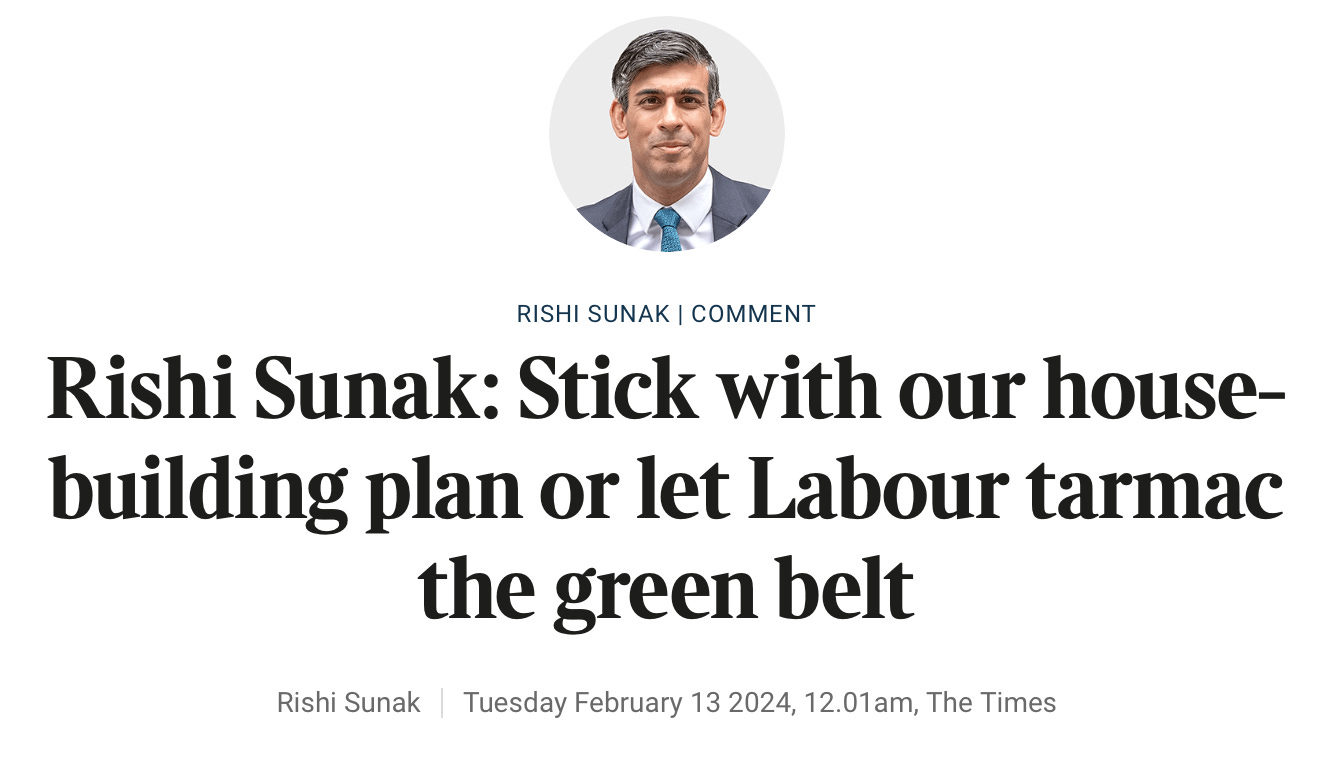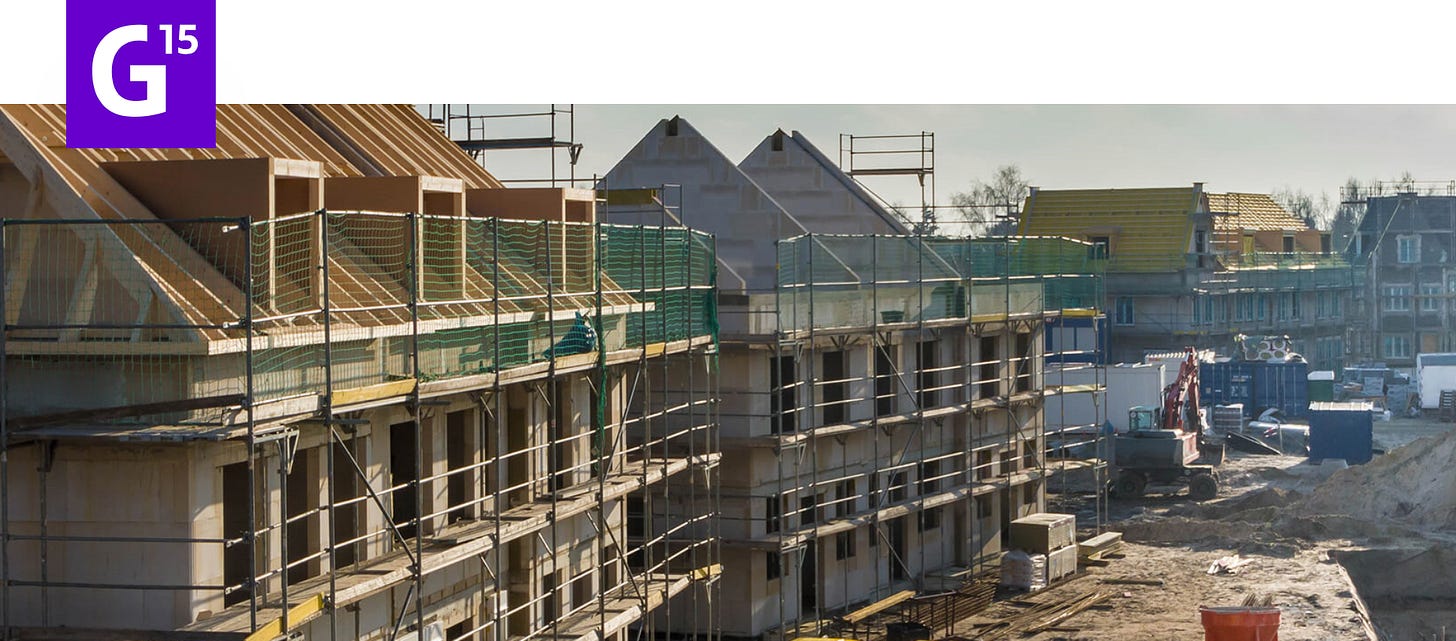The Housing Question No 13: Solving the housing challenge
Why this week’s welter of announcements fail even on their own terms, why the Conservatives can’t escape an electoral trap of their own making and why they don't mention affordability.
Welcome to the latest issue of my newsletter on everything to do with housing in the UK and beyond. The Housing Question is still a work in progress but seems to be settling down into a fortnightly schedule. If you like what you read please consider subscribing (it’s free for now) and sharing links on social media.
Common sense and weasel words
‘Our long-term plan for housing is working,’ claims Rishi Sunak in an article in The Times this week. Nobody believes it, possibly not even him.
The prime minister was summing up his government’s latest series of announcements on housing but one sentence in it grabbed my attention.
‘To solve the housing challenge, we must ask not just “how many”, but “where”.’
Sunak obviously can’t bring himself to say ‘crisis’ because that would imply that something more fundamental has gone wrong. As the title of this newsletter implies, I don’t like to use that term either: problems with housing have developed over years and on many different levels. A whole series of crises and scandals add up to a much bigger, more structural question to which boosting home ownership and even building more homes are only part of the answer.
‘Housing challenge’ is a weaselly way of looking at it, though, a step down from ‘crisis’, ‘emergency’ or ‘question’ that suggests something that can be ‘solved’ by the right prime minister. And the rest of the sentence is of course a reference to the archetypally weaselly solution of ‘the right homes in the right places’. Building more homes (how many) has become considerably more difficult as a direct result of Sunak’s surrender to his own backbenchers over planning and housing targets but happily for the Conservatives they can be built in Labour seats in urban areas (where).
The ‘solution’ assumes that all the homes we need can be built on brownfield land despite all the evidence to the contrary. Successive governments have prioritised brownfield as a way of avoiding more uncomfortable questions about greenfield land and the Green Belt. An independent review of the London Plan was set up as a nakedly political attempt to embarrass Labour mayor Sadiq Khan over his under-performance on housing. Though it does find evidence of duplication between London boroughs and the Greater London Authority and an array of confusing planning policies, the largely sensible report fails to find a smoking gun. Instead it recommends a presumption in favour of brownfield development in parts of London that fail to meet their Housing Delivery Test targets.
Fresh from the surrender to Tory rebels over targets, housing secretary Michael Gove now wants to apply them to the 20 largest cities and towns by extending this presumption, even though most of them already meet the test. He is also planning to relax the rules on permitted development even further, allowing more commercial buildings to be converted into flats without planning permission.
The point of this plus all the other housing announcements this week is to make it look as though the government is doing something ‘to solve the housing challenge’ but you do not have to look very far to find more heat than light. An early clue comes in the clumsy phrasing of the press release announcing them:
‘The focus on brownfield land and urban development is part of the government’s plan to take a common sense to delivering the housing that is needed, protect the countryside and Green Belt.’
I can only assume that ‘common sense’ is so obvious to Conservatives (Esther McVey, ninth of the 16 housing ministers since 2010, is now minister for it) that nothing more needs to be said but the missing word exposes the vacuity of what follows.
Another clue comes in a caveat added to the presumption in favour of brownfield recommended by the independent review (my emphasis):
‘This new approach will put rocket boosters under brownfield regenerations projects across the country and provide the new homes the country needs, without affecting existing protections including for residential gardens, and ensuring protection for the character of suburban neighbourhoods.’
It’s hard to imagine a site much more brownfield than a tube station car park, but it was plans to build on them in outer London that sparked what became the Tory rebellion led by Theresa Villiers. ‘Protection for the character of suburban neighbourhoods’ is a get-out clause for Tory constituencies in outer London that oppose ‘building up’ with blocks of flats.
They are even more opposed to ‘building out’, of course, and will fight the next election on Labour’s supposed plans to ‘tarmac the green belt’. As Sunak puts it:
‘We need to build homes in the places where people need and want them. There’s little point trying to force large new estates on our countryside and green belt when that is where public resistance to development is strongest and where the GP surgeries, schools and roads don’t exist to support new communities.’
This is a circular argument. People may well ‘need and want’ houses rather than flats, especially in the wake of all the problems with building safety and leasehold. Greenfield sites will, by definition, lack GP surgeries, schools and roads. Good developments plan for them and build them from the start. A good planning system should ensure that applies to all developments. There is no way to achieve the government’s manifesto target of 300,000 new homes a year from brownfield sites in non-suburban parts of big towns and cities.
Many Tories know this and they know that it is directly linked to their fading electoral prospects among the under-40s and even everyone under 70. Michael Gove knows it, telling the Sunday Times that falling prospects of home ownership mean that a growing number of young people no longer believe in markets or democracy that are not working for them. But he is just the latest Conservative minister to discover that for the bulk of the party pandering to its base of older, existing home owners trumps all that. Solving ‘the housing challenge’ means trying, and failing, to straddle that gap.
My column for Inside Housing this week has more on the alternate realities in this week’s announcements.
London’s ‘broken system’
How about asking ‘how much’ as well as ‘how many’ and ‘where’? Affordability was the big thing missing from this week’s announcements.
Construction of affordable housing in London is set to plummet this year, warn the G15 group of the largest housing associations operating in the capital and the Centre for London think tank.
In a joint open letter to Michael Gove, they say starts of affordable homes are set to fall by 76 per cent, from 7,363 in 2022/23 to 1,769 in 2023/24. G15 chair Fiona Fletcher-Smith and Centre for London chief executive Antonia Jennings tell the housing secretary:
‘Your recent interventions do not go far enough to address what, by your own admission, is a broken system. The issues plaguing the current housing market go back decades and have been entrenched by short-term fixes.’
The precipitous fall is the result of a squeeze on housing association finances caused by higher interest rates, inflation in costs of construction plus rising costs to rectify fire safety problems, bring older stock up to a decent standards and fix damp and mould problems.
The warning puts this week’s announcements in general, and the politics of Sadiq Khan’s overall record on housebuilding in particular, into perspective. Brownfield development is about funding – for site remediation, infrastructure and affordable homes – as well as planning. The open letter says that:
‘Despite the crisis facing Londoners, the Government has failed to step up and invest in the delivery of social housing. Insufficient sustainable funding, among many structural issues, is a critical reason why housing is in crisis in our capital city.’
The G15 calls for £15 billion a year of investment over the next decade to build 90,000 homes a year, including 30,000 in London. That compares with an Affordable Homes Programme worth £11.5 billion between 2021 and 2026, including £4 billion in London. Homes England warned recently that output will be ‘some way’ lower than even its revised target. The £3 billion extension of the Affordable Homes Guarantee Scheme – details announced this week – is a welcome but inadequate intervention.
Future spending plans in last year’s Autumn Statement imply that even £11.5 billion could look generous in the next spending review. The plans involve unfeasibly large cuts in public services and a freeze (aka real terms cut) in capital investment. And that is before room is found for pre-election tax cuts.




